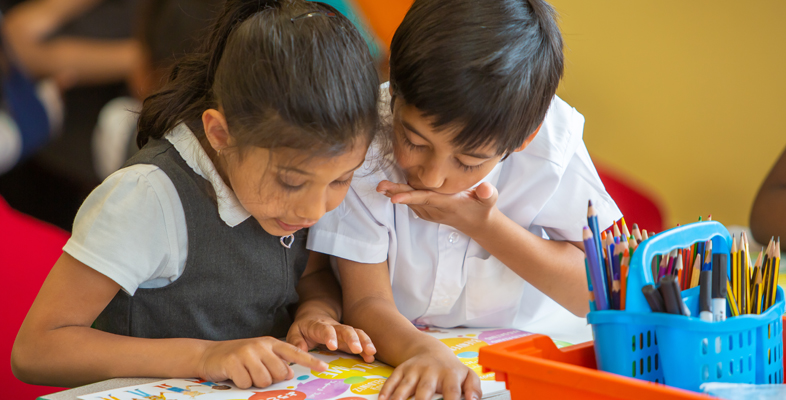References
de Bondt, M., Willenberg, I. A. and Bus, A. G. (2020) ‘Do book giveaway programs promote the home literacy environment and children’s literacy-related behavior and skills?’, Review of Educational Research, 90(3), pp. 349–375. doi: https://doi.org/10.3102/0034654320922140.
Cremin, T. (2019) Reading Communities, what how and why. Available at: https://cdn.ourfp.org/ wp-content/ uploads/ 20210301105855/ Reading_Communities_TCremin_2019.pdf?_ga=2.134846385.1937271030.1633344484-218333398.1633344484 [Tip: hold Ctrl and click a link to open it in a new tab. (Hide tip)] (Accessed 14 September 2021).
Cremin, T., Mottram, M., Powell, S., Collins, R. and Safford, K. (2014) Building Communities of Engaged Readers: Reading for Pleasure. London and NY: Routledge.
David, A. (2020) Reading to children is so powerful, so simple and yet so misunderstood. Available at: https://www.teachearlyyears.com/ learning-and-development/ view/ reading-to-children-is-powerful-simple-and-yet-so-misunderstood (Accessed: 16 September 2021).
Evans, M. D. R., Kelley, J., Sikora, J. and Treiman, D. J. (2010) ‘Family scholarly culture and educational success: Books and schooling in 27 nations’, Research in Social Stratification and Mobility, 28(2), pp. 171–197.
Hall, M., Levy, R. and Preece, J. (2018) ‘“No-one would sleep if we didn’t have books!”: Understanding shared reading as family practice and family display’, Journal of Early Childhood Research,16(4), pp. 363–377.
Hindin, A., Steiner, L. and Dougherty, S. (2017) ‘Building Our Capacity to Forge Successful Home-School Partnerships: Programs That Support and Honor the Contributions of Families’, Childhood Education, 93(1), pp. 10–19.
Kinzer, C., Leu, D. and Peters M. (2016) ‘New literacies and new literacies within changing digital environments’, in Peters, M. (ed) The encyclopaedia of educational philosophy and theory. London: Springer.
Knoester, M. and Plikuhn, M. (2016) ‘Influence of siblings on out‐of‐school reading practices’, Journal of research in reading, 39(4), pp. 469–485.
Kucirkova, N. and Littleton, K. (2016) The Digital Reading Habits of Children: A National Survey of Parents’ Perceptions of and Practices in Relation to Children’s Reading for Pleasure with Print and Digital Books. London: Book Trust.
Levy, R. (2011) Young Children Reading at Home and at School. London: Sage
Little, S. (2021) ‘Rivers of multilingual reading: exploring biliteracy experiences among 8-13-year old heritage language readers’, Journal of Multilingual and Multicultural Development. doi: 10.1080/01434632.2021.1882472.
Mackey, M. (2021) ‘Access, Choice, and Time to Read: A Reader-Driven Perspective on Social Justice’. OU literacy and Social Justice centre seminar. 12 May.
Mallette, M. and Barone, D. (2016) ‘Unite for Literacy: An Interview with Mark W.F. Condon’, The Reading Teacher, 69(5), pp. 471–481.
Marsh, J. (2003) ‘One-way Traffic? Connections between Literacy Practices at Home and in the Nursery’, British Educational Research Journal, 29, pp. 369–382.
Maybin, J. (2007) ‘Literacy under and over the desk: oppositions and heterogeneity’, Language and Education, 21(6), pp. 515–530.
McGrane, J., Stiff, J., Baird, J., Lenkeit, J. and Hopfenbeck-Oxford, T. (2017) Progress in International Reading Literacy Study (PIRLS): National Report for England. Available at: https://assets.publishing.service.gov.uk/ government/ uploads/ system/ uploads/ attachment_data/ file/ 664562/ PIRLS_2016_National_Report_for_England-_BRANDED.pdf (Accessed: 16 September 2021).
National Literacy Trust (NLT) (2019) Gift of reading: children's book ownership in 2019. Available at: https://literacytrust.org.uk/ research-services/ research-reports/ gift-reading-childrens-book-ownership-2019/ (Accessed: 7 October 2021).
Nicholas, M. and Paatsch, L. (2018) ‘Mothers’ views on shared reading with their two-year olds using printed and electronic texts: Purpose, confidence and practice’, Journal of Early Childhood Literacy. doi: 146879841879261.
Picton, I., Clark, C. and Judge, T. (2020) Video game playing and literacy: a survey of young people aged 11 to 16. A National Literacy Trust research report. Available at: https://cdn.literacytrust.org.uk/ media/ documents/ Video_game_playing_and_literacy_report_final_updated.pdf (Accessed 16 September 2021).
UNICEF (2021) COVID-19: Schools for more than 168 million children globally have been completely closed for almost a full year, says UNICEF [Press release]. 2 March. Available at: https://www.unicef.org/ press-releases/ schools-more-168-million-children-globally-have-been-completely-closed (Accessed: 16 September 2021).
Wiescholek, S., Hilkenmeier, J., Greiner, G. and Buhl, H. (2018) ‘Six-year-olds' perception of home literacy environment and its influence on children's literacy enjoyment, frequency, and early literacy skills’, Reading Psychology, 39(1), pp. 41–68.
Worthy, J., Nuñez, I. and Espinoza, K. (2016) ‘“Wow, I Get to Choose Now!” Bilingualism and Biliteracy Development from Childhood to Young Adulthood’, Bilingual Research Journal, 39(1), pp. 20–34.
